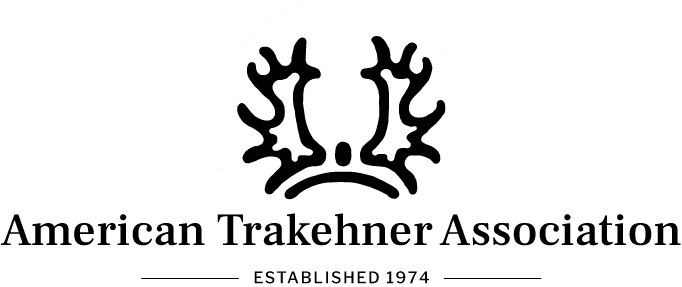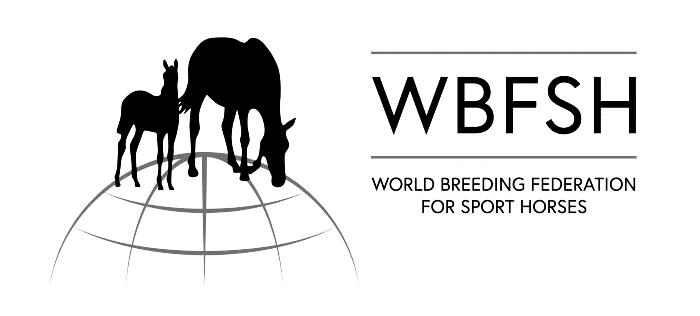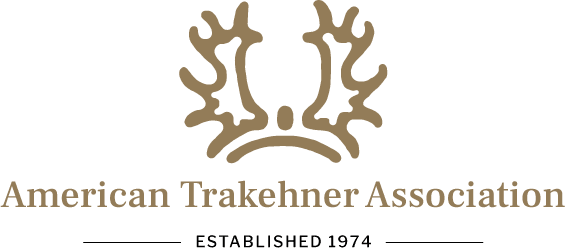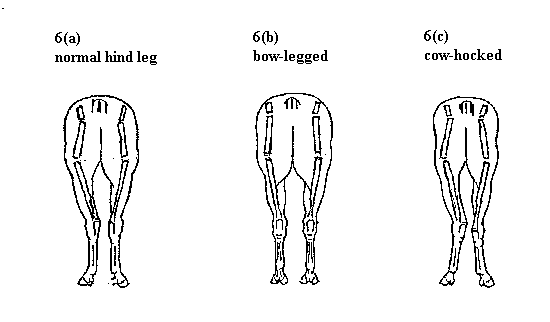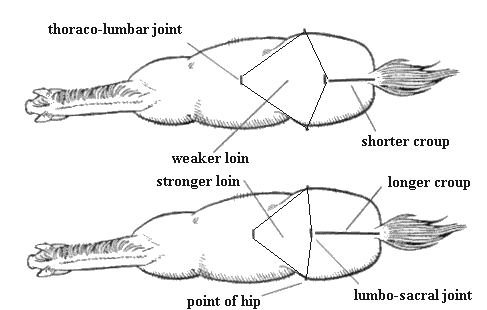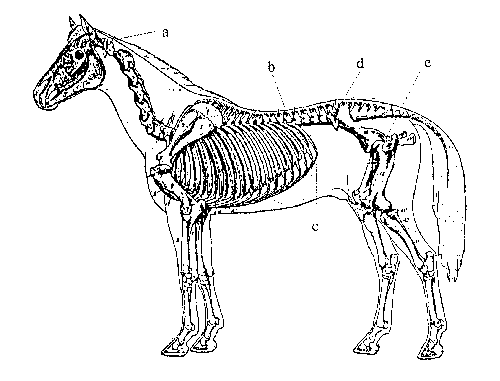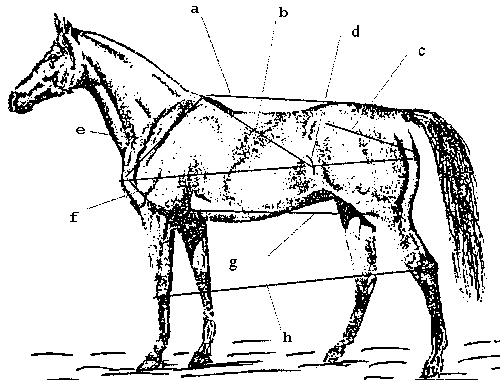The best general impression of the balanced conformation of a horse is usually created when it is viewed for the first time from a distance, preferably of fifty feet or more. From there it can be seen if the horse is ‘well put together’ and made up of three well-connected or three ‘separate’ parts. Features such as a stallion neck, a ewe neck, a sway back, a long back, a short, flat croup, and so on, are often seen more easily when the observer is standing back. It is of even greater value if the horse can also be seen moving at liberty in a quiet, enclosed arena at this time. This allows for a positive first impression of the horse’s basic movements and natural athleticism. Only then should the specific parts be examined more closely.
The horse must always be looked at as a single unit, but, for the purposes of discussion, he may be ‘divided’ into the following four sections:
1. The head and neck.
2. The back, including the croup.
3. The shoulders and front legs.
4. The quarters and hind legs.
1. The Head and Neck:
Desirable features include a wide poll, widely separated, large eyes, an open throat latch, wide cheek bones and large nostrils.
The length of the neck is important, as it must be in proportion to the frame. It is often said, but wrongly so, that longer-necked horses are more athletic. Necks which are very long tend to be stiff and lack balance. If the neck is too long the laryngeal nerve may be stretched and injured, sometimes resulting in ‘roaring’. Expert opinion varies on the inheritability of roaring, but it frequently occurs in long-necked horses, and it may be that the neck length is the significant factor.
It is also of importance to ensure that the structure of the neck vertebrae is such that a shallow ‘S’ is formed, with the first two vertebrae joining the skull from ‘above’ (Click to View Figure 2). In ewe necks, which are to be avoided, they join from ‘below’.
In a good neck, the widest part – which lies just below the level of the withers – is high, while in a ewe neck it is lower. The higher its widest point, the less distance it has to move to get up to the arched position in which the horse accepts the bit. The arching configuration of the neck – when the horse goes ‘on the bit’ or ‘stretches to the bit’ – originates at the base. It occurs when a stallion teases, or when a horse reaches for food. It occurs over jumps, and in dressage it allows for a convex front leg at the trot. In contrast, a hollow neck produces a concave leg and a flicking action of the foot. Also, pressure of the calf of the rider’s leg against the rib cage stimulates the reflexes which stretch and arch the neck, raising its base. A horse with a ewe or lowset neck is difficult to train.
The throat latch, the space between the back of the jaw and the top of the neck, needs adequate space to make it easy to flex at the poll. If the area is thick and heavy, the throat latch will be tight. However, some horses have difficulty flexing at the poll because the neck muscles are tight, not because the throat latch is heavy.
The withers are the spines of the 2nd to 8th thoracic vertebrae. They should be sloping but well-defined, and the farther back they lie behind the elbow, the greater the scope of the fore limbs.
The head itself is important in assessing the qualities of a sport horse, and some faults are significant. Particularly undesirable are a very small head, small nostrils, parrot mouth or overbite, a heavy jaw, and small ‘bug’ eyes. Some faults are of less importance, and some so-called faults are not faults at all. For example, the plain, heavy head, sometimes seen on the English hunter, and formerly on the older type of warmblood, does not reduce performance, perhaps even enhances it. Depending on the length of the neck, there is evidence that a heavier head may be mechanically more balancing than a smaller, lighter one.
A neck which is too long is predisposed to dislocations of the vertebrae and damage to cervical nerves, which may result in faulty coordination or ataxia (wabbles). And, as mentioned earlier, it may also produce vocal chord paralysis (roaring).
2. The Back, including the Croup:
Anatomical guidelines (Click to View Figure 1):
- Back length – peak of withers to peak of croup (lumbo-sacral joint).
- Body length – point of shoulder to point of buttock.
- Rib cage length – peak of withers to the last rib.
Inspected from behind, and above if possible, the spine should be in the midline from the poll to the tail, with the muscle bulk equal on each side. Slight asymmetry is acceptable, as long as the tail is carried in the mid-line. Off center tail carriage may be an important indicator of an anatomical defect. In a riding horse, it may also result from ‘overwork’, particularly when the horse is asked to make repeated circles on one hand, resulting in spasm of the paravertebral muscles on that side.
The loins, the withers and the length of the back are inspected from the side.
The ideal loin (Click to View Figure 3) is a triangular area whose apex is the vertebra where the last ribs join the spine (T18, the thoraco-lumbar joint) and whose base is a line joining the points of the hips. This area should be short from back to front, wide across, convex, smooth and be of a firm, elastic consistency.
Flexion of the lumbo-sacral joint (L-S) permits the loins to coil by using the so-called ‘ring of muscles’ which stretches from the poll to the hocks. This flexion occurs at the facet joints of the two vertebrae involved. The facet joints are bony prominences, which project from behind and to the sides of each vertebra, and allow for articulation of the vertebra with its neighbor above and below. The ‘sitting down’ action of the horse – as seen in a jumper at take-off, a dressage horse in the piaffe, a quarter-horse sliding to a stop, or racehorse in the starting gate – requires flexion of the lumbo-sacral joint at the ‘loin coupling’.
The L-S joint is the most important joint in the horse’s body in determining the ability to move well. It should be as far forward as possible.
Seen from the side, it is best when the pelvic bone is long, and the peak of the croup is directly above the point of the hip, making the croup (the sacrum) as long as possible. Flexion in the lumbo-sacral joint is the main cause of bascule, and the longer the pelvic bone, the more leverage can be developed.
In contrast to the triangular area referred to as the loin is the lumbar span. It is the segment of the spine from T18, where the last ribs are connected, to the lumbo-sacral joint at the forward end of the croup, but not extending laterally to the points of the hips (Click to View Figure 2b to 2d). This lumbar span is the weakest area of the back. Unlike the spines above and below which have the ribs and pelvis attached, it has no other supporting bones. Unfortunately, this is the area where much of a rider’s weight is carried. When the lumbo-sacral joint is forward and the croup is lengthened, the lumbar span is shortened and the stress to which it is subjected is minimized.
The distance from the peak of the croup to the root of the tail should be long. The longer the croup, the greater the leverage on the spine in general, and on the L-S joint in particular. Combined with a long pelvic bone, whose angle with the horizontal is greater than 15°, a long croup facilitates more efficient bio-mechanical leverage and flexion.
The pelvis anchors and supports the horse’s muscles of impulsion, and the larger the pelvis the greater the potential power.
The hip joint socket may be identified as a slight hollow indentation about halfway along the pelvic bone. The farther forward it lies on the pelvic line, and the nearer to the midpoint of the bone, the longer will be the ischium (the ‘seat’ bone), giving greater leverage. Loin coiling is mechanically more efficient if the distance from the L-S joint to the hip socket is short.
The point of the hip to the point of the buttock should be at least 30% of the body length. (Some thoroughbreds have as much as 38%.) However, even with a large pelvis, a long-backed horse may still have a reduced pelvic / body-length ratio.
In principle, the efficiency of movement is determined by the back length – that is from the withers to the L-S joint.
- Back length should be less than 50% of body length (best at 40-45%).
- Rib cage length should be greater than back length (best at 105%).
Looked at from the side, a vertical line through the last rib should be not more than six inches from a vertical line down from the point of the hip; and the measurement of the belly at the groin, below the L-S joint, should be only slightly less than at the chest.
Good body proportions allow the horse to collect, extend and turn athletically. However, a long back and a long rib cage can give a smooth ride with good turns and lateral movements, but such a horse will usually have difficulty with collection.
Lightness comes from a combination of engagement of the hindquarters and arching, rounding or basculing of the back.
Engagement of the quarters means ‘coiling of the loins’. Over a jump, a horse will flex his lumbo-sacral joint, coil the loins and hindquarters, stretch the neck and bend the joints of the front and hind legs.
The ‘ideal’ riding horse is rectangular, with the body length about 10% greater than the height. It has a back of medium length, in which the thoracic vertebrae (which carry the ribs and are both longitudinally and laterally flexible) account for most of its length.
A short back is stronger and easier to coil (bascule), but may feel ‘stiff’, have difficulty with lateral bending and give an uncomfortable ride. On the other hand, a long backed horse has difficulty with the bascule, but may find lateral bending easier to perform. However, with a long back, a relatively weak loin but with good training, some horses are capable of performing fairly well. They may be able to jump more than four feet, and in dressage may move well enough to perform Prix St. Georges movements. It is, however, unlikely that such movements will be carried out correctly, with efficiency, showing a good bascule.
Young horses, especially warmbloods which may mature late, are sometimes seen to be higher at the croup than at the withers. At this stage in development they may move poorly, picking up the hind legs in a stiff manner with insufficient flexion of the stifles and hocks. As the structure becomes more balanced the loin, stifles, and hocks will show an increased range of movement, and the hindquarter will be able to engage more effectively.
If the horse is long-legged, it may over-reach and interfere with the foreheels. That leads to a shortened hind stride, a tendency to carry the quarters to one side, and, at the canter, traveling wide behind by spreading the hind legs.
Horses under saddle frequently develop thickening of the spines of T18 and L1, the two vertebrae which comprise the thoraco-lumbar joint (Click to View Figure 2). This thickening may result in back pain and leg lameness.
A long loin, a weak coupling, and a ‘table-top’ croup, if accompanied by upward tipping of the rear of the pelvis, produces serious mechanical disadvantage.
Finally, some so-called conformation ‘faults’ are the result of injury and are not inherited. They include ‘hunter bump’ and subluxation of the lower back, while a ‘roach back’ indicates a misalignment of the lumbar vertebrae.
The Ring of Muscles:
The ‘ring of muscles’ (sometimes referred to as the ‘circle of muscles’) is a ligamentous and muscular system which stretches from the poll to the hocks, with a forward extension under the abdomen. It was first described by Gustav Steinbrecht in 1889; later by Waldemar Seunig (1941), Gustav Rau (1948), and Jean Froissard (1967), and referred to in detail by Dr. Deb Bennett in her ‘Equus’ articles (1988-1990).
The ring of muscles and ligaments is essential for normal locomotion in the horse, and the lumbo-sacral joint is the center point of this system. Any discussion on equine conformation must begin here.
All desirable movements of the horse – impulsion, collection, engagement, lightness, and stride length – originate in these ring muscles. Dr. Bennett calls it ‘the unifying principle of riding.’
From the side, the triangle of the loin area is short, smooth and muscular, with the L-S joint lying about three inches deep to the peak of the croup.
A horse is said to be ‘close coupled’ (sometimes described as having a ‘good connection’) when there is a short and firm connection between the withers and the croup, primarily the result of a short loin.
The main leverage point in the forequarter is the withers; the main leverage point in the hindquarter is the lumbo-sacral joint. A well-attached neck and tall withers give great leverage, so that lowering the head and arching the neck elevates the back with ease. With a ewe neck, it fails to rise.
Flexion in the L-S joint, the last joint in the ‘loins’, is the main cause of bascule.
The major muscles in the system – the iliopsoas in the pelvis, and the external and internal oblique and the rectus abdominis muscles of the abdomen – complete the ring. A horse with a deep groin, almost as deep as his girth, has more muscle mass in the abdomen and can bascule and engage the hindquarters more easily and carry the rider more effectively.
Contraction of the muscles of the neck (scaleni), the rump (iliopsoas) and the abdomen, ‘pull’ on the spine from the poll to the croup. The dorsal ligament firms up, especially over the fulcrum at the withers and at the L-S joint. The neck arches, its base rises, the back is elevated and the back of the croup is pulled down. The efficiency of this entire action is reduced with a ewe neck, a long back and decreased muscle mass in the pelvis and abdomen.
A strain on the L-S joint stretches the lumbo-dorsal fascia, creating an undulating, broken top line, resulting in difficulty in coiling the loins. Stretching and thinning of the fascia leads to a herring-gutted, wasp-waisted horse. The hunter bump (the stretching and partial separation of the sacro-iliac ligaments) is usually worse on one side, and is best seen from behind.
The angle of the pelvis with the horizontal should be at least 15°, and is best if between 18-22°. Less than 10° should be rejected for breeding, as loin coiling is made much more difficult the more horizontal the slope. Mares with less than 10° may have a tilted vulva and vagina, and will probably have difficulty conceiving. A goose-rumped horse has more than 28°, and usually has a very strong back.
The most important quality of the riding horse is its ability to carry weight. That in turn depends on a well-structured back, which is slightly convex, the result of flexion of the L-S joint, and also, of course, sound and correctly built legs.
Impulsion is the action of driving the basculed body forward with the propulsive muscles of the hindquarters, not the hocks. A horse without a bascule is a horse without impulsion. A horse without impulsion is grossly inefficient, and is prone to injury and premature unsoundness.
The signs of ring function are:
- engaging the hindquarters;
- rounding the back;
- arching and reaching of the neck.
3. The Shoulders and Front Legs:
Anatomical references (Click to View Figure 2), (4a and 4b): withers; scapula; point of shoulder; arm; point of elbow.
The shoulder blade, or scapula, is a somewhat flat bone which has a spine or ridge running down its center. This ridge is the bone which is felt when the shoulder is palpated. The scapula may have an upright lie (60° or more to the horizontal), or be laid back at about 45°. While this angle is important, of even greater significance is the angle created by the shoulder relative to the arm (the humerus).
The two most important proportions in relation to the shoulder are the angle created by the scapula and arm, and the length of the arm relative to the scapula. The lie of the shoulder is important only in its relationship to the arm. The angle from the peak of the withers to the point of the shoulder to the point of the elbow, must be greater than 90°.
In an upright shoulder, the bone is more mobile and can rotate to the front of the chest more fully. It allows for a high knee action and is essential if the jumper is to be able to clear large obstacles. Some disadvantages are that the foot strikes the ground farther back, with the danger of interference, and the front end movement in all gaits has less forward scope. It also gives a more rigid ride and makes the foreleg more prone to concussion injuries and reduced soundness. The horse may also stand under.
The shoulder which is laid back is already partly rotated in front of the chest. This permits a forward-reaching action desirable in dressage (Figure 4a). But such a horse may move in a stiff-legged, short striding manner when the angle of the scapula and humerus is closed at less than 90°.
The arm should be long, at least half the length of the shoulder. Its length determines the horse’s ability to move the elbows away from the ribcage towards the front or the side. The steeper it is, the greater its range of motion. This quality is especially important for jumpers and event horses when faced with big spreads and water jumps and the need to raise the elbows and knees up towards the ears over large verticals. It is also essential for lateral work in dressage.
The arm is connected to the shoulder-blade with a ball and socket joint (Figure 4b). It controls the way the horse folds and unfolds the elbow, knee and fetlock joints. The longer the bone, the more expansive the gait; the shorter, the more choppy.
With tight elbows and good legs, the toes will turn out. With loose elbows, and good legs, the toes will turn in.
The scapula is loose and slides and glides forward and back when the horse moves. The breast bone or chest can vary from being pointed or very square. If square, the scapulae glide up and down but not much forward. A chest of good proportion is one in which a ‘third’ leg will fit neatly between the other two.
A major cause of a horse moving with short strides may be that the ‘sling’ muscles (pectoralis major) are tight. This is more likely if the horse has not been trained and has never been in self-carriage. With training, these muscles can be lengthened and the stride increased.
Front Legs:
The front legs are columns of support (Figure 4a). They bear 65% of the weight of the standing horse, and are, therefore, particularly vulnerable to the stresses and strains of jumping and galloping. They are not involved in the propulsion of the horse.
Ideally the forearm (radius and ulna) is long, strong and vertical; the knee joint (carpal bones) is large, flat in front and tilted forward minimally; and the cannon bone (metacarpal) is short and vertical. The shorter the cannon bone, the stronger the leg. The pastern bone should be at least 1/2 but less than 3/4 the length of the cannon bone.
Toeing-out with external rotation of the limb is often seen in young and untrained horses. It occurs when the elbows are tight and may be self-correcting when the muscle tone improves with training. Hoof trimming to correct the ‘problem’ during the young horse’s growth period should be discouraged. It can cause contraction of various groups of tendons and may result in permanent misalignment such as offset (bench) knees, calf knees, tied-in knees, internal rotation of the cannon bones and fetlock joints and upright pasterns. These deformities may, of course, be due also to inheritance.
Toeing-in in the young horse is usually the result of loose elbows, and, like toeing-out, may be similarly self-correcting with training.
In all sport horses, but especially in breeding stock, the hooves should be of even size, with the front slightly bigger than the hind. They should all be large and round with open heels, and small, contracted or uneven hooves should be avoided.
The pastern angle is best at 45°. It should be first observed at rest, and any significant increase in the degree of flexion noted when in motion is a good indication whether the horse is on the forehand.
Front leg excellence is essential in jumpers and event horses, but less important in dressage horses which work almost exclusively from their hindquarters and hocks.
In the forelimb, minor degrees of external rotation and lateral deviation – the latter may originate below the knee or at the pastern – may be acceptable, even in breeding stock. By way of a simple test, using a firm and level surface, if the horse trots without evidence of ‘paddling’ or ‘winging’, slight variations of these conditions may be acceptable. Further, when external rotation is seen from in front, and before making an adverse judgement, the knee should also be examined carefully from the side. From this perspective the rotation is often seen to be minimal, and likely to be of little mechanical significance.
4. The Quarters and Hind Legs:
Anatomical references: point of hip; point of buttock; last rib; stifle joint (lateral condyle of femur); hip socket; pelvic length – pt of hip to pt. of buttock.
The hindquarters extend from the front of the croup (lumbo-sacral joint) to the hooves, and supply the power for forward and upward movement. They should be examined from the side and from the rear.
It is of paramount importance for all, but especially for dressage riders, to know that collection starts with flexion of the L-S joint, the point where the loins meet the croup. For the stifles to bend, the loins must flex. Whatever the loins do, the stifles must follow; and whatever the stifles do, the hocks must follow.
When the horse coils the loins, the back and the root of the neck rise, and the pelvis and hocks are tucked under the body. This is engagement.
To enable the horse to coil for collection and jumping, and of special importance for dressage and jumper horses, the pelvic length should be 1/3 or more of the body length, with a slope of 18-22°. This promotes an ideal mix of suspension and thrust. At the very least the pelvic slope must be 15°. A horizontal pelvic bone makes flexion more difficult and may lead to a chronic hollow back which is prone to injury.
The muscles of the quarters – the gluteus medius, femoral biceps, semi-tendinosis and semi-membranosis – must be large, evenly and well developed. This is the ‘engine’ of the horse from which propulsion originates.
The Hind Leg from the side:
From the side (Figure 5), the angle at the hock may be:
- Normal: with the cannon bone vertical, the point of the hock lies directly below the point of the buttock;
- Over-angulated: too closed an angle at the stifle and the hock (sickle-hocked; crooked; z-shaped; camped out);
- Straight-legged: open angled, post-legged (over-straight; usually coon-footed).
Ideally, when the hind cannon bone is vertical, the point of the hock should lie directly below the point of the buttock, and the stifle should lie directly below the point of the hip.
Tracking up is easy if the hind leg angle is normal; it is inevitable if sickle-hocked; and very big if the horse is sickle-hocked and can coil the loins.
Open hind leg joints at the hock (straight legs), as seen from the side, are mechanically very efficient. Less energy is lost when it is thrust straight down the bone columns. The walk is usually reduced in scope, but it may be acceptable or even good if the loin flexes efficiently. These horses make good race horses, steeplechasers and jumpers.
If the angle is too open at the stifle, there is a tendency to subluxation of the patella. If too open at the hock, concussion may lead to premature arthritis. Closed or more angled hind limb joints are preferred for dressage, but if too long and angled, especially at the hock, soft tissue injuries such as curbs and spavins are more common.
The longer the horse’s hind limb, the easier it is to bring the hocks and hind hooves under the body.
Modern riding horses are bred to have low hocks, but it is important that this be achieved by having a long femur, one which is longer than the tibia (gaskin). A long femur lowers the stifle which, in turn, lowers the hock. This permits a slow, relaxed and rhythmical hind leg action.
When the gaskin is too long, the entire hind leg is usually too long. This causes the stifle to flex less than is desirable, the hock then hyperflexes, causing stringhalt. These horses often show an impressive walk due to a significant overstride, but at the trot, seen from behind, the horse in often bow-legged, and the hocks move in a ‘wobbly’ fashion, rotating to the outside before straightening when the weight is transferred to the other foot. This leads to spavin and to injuries to the stifle and patella. A horse with long gaskins is more likely to be cow-hocked or bow-legged (Click to View Figure 6). (In sprinting race horses, a short femur is more desirable as the horse is required to flex the femur more rapidly and efficiently.)
It is desirable for the hocks to be lower rather than higher. They should be higher than the knees, and the stifles should be lower than the elbows.
The Hind Leg from behind:
- Ensure that the feet are square and the cannon bones vertical.
- The stifles must be more lateral (further out) than the hips.
- The stifles should be ‘turned out’, the hocks ‘turned in’, the cannon bones vertical and the hooves turned out.
- In humans, the lower edge of the femur and the upper and lower edges of the tibia are at right angles to the shaft. These edges are oblique in the horse, so that when the bones fold, they do not fold parallel to the midline of the body. They turn slightly outwards, clearing the horse’s abdomen as the leg moves forward. The stifles miss the belly, and, although the feet are turned out, they move straight forward.
- Mares’ quarters are often square, while stallions’ and geldings’ are wedge-shaped.
Hind limb conformation has several variations when seen from behind (Click to View Figure 6):
- Normal: stifles face out, hocks point in, toes face out, at the same angle as stifles;
- Bow legged: stifles face out, hocks point straight back, toes face straight forward or inward. When the horse moves, the hocks swing outwards like elbows;
- Cow hocked: stifles face straight forward, hocks point in towards each other, and toes face out. The weight is on the inside edges of the hind hooves.
The hind limbs are the objects of forward and upward movement. They are not columns of support, as they carry only 35% of the horse’s weight.
Ideal Hindquarters:
- a broad pelvis;
- muscular thighs;
- stifle caps pointing out;
- muscular gaskins;
- hocks broad and angular, from front and side; rear surfaces equally broad and lying below the points of the hocks; clean and dry with no puffiness;
- hind cannon bones attached in the center below the hocks; hind pastern angle 40-45°;
- open heels, substantial feet, regular hooves, evenly worn.
The pelvis is the source of power. The Arabian has a smaller pelvis, but it is still usually at least one third of body length. A flat croup may be acceptable, but only if the angle of the pelvis is maintained at 15° or more.
